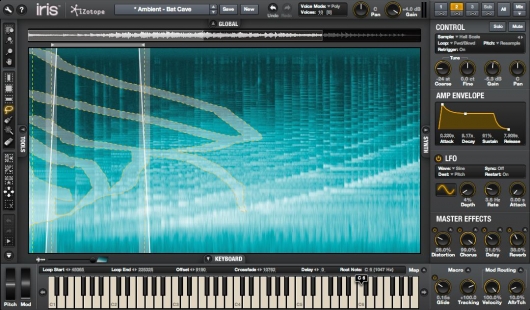Review: Izotope Iris
One of the heavy hitters in the visual sound editing business, iZotope‘s spectrogram-based audio restoration […]

One of the heavy hitters in the visual sound editing business, iZotope‘s spectrogram-based audio restoration suite RX has long been aimed at those looking to clean, polish, and otherwise restore audio files. With Iris, the developer has taken this fairly mundane concept and transformed it into a plugin that’s being called a “sampling resynthesizer,” aimed primarily at music makers.
The software visually maps out sounds in three dimensions: The X-axis represents time, the Y-axis represents frequency, and the third, amplitude, is indicated by brightness. Drag in a sample, and Iris automatically detects the pitch and maps it across the keyboard: lower is slower, higher is faster. Unlike standard waveform-style audio editors, however, the Spectral view lets you isolate specific parts of the sound spectrum that you want to hear, achieved with various graphical editing tools.
Though the interface can be somewhat intimidating at first—this is not exactly “pick-up-and-play” software—once you wrap your head around it, editing sounds is a fun, visually-assisted process. The Photoshop-equivalent “magic wand” selection tool can detect harmonic content that’s similar to the current selection, as well as related harmonic overtones with a second click. You can essentially “mask out” aspects of the sound that you don’t like, allowing for an incredible amount of fine-tuning. The potential for personalization and philosophical nuance is compelling: Want to make a drum sound out of a sample of your cat purring, or harmonics out of a sample of your grandfather’s rocking chair? Essentially any sound can be made musical, in any number of different ways.
And then there’s the ability to combine. You can mix four separate channels of your sampled and edited sounds, send the results through a filter, and then apply up to four effects (distortion, chorus, delay, and reverb) to the signal. Each of the sample slots has standard ADSR envelope and knobs that control tune, gain, and pan, and each sample also has its own LFO (with various waveforms to choose from). It’s a unique process, and once you get familiar with it, the sound sculpting possibilities are endless. Iris comes with a 4 GB sample and patch library, ranging from crazy experimental samples to layered acoustic instruments. iZotope has two additional libraries available as well (wood and glass), and you get those at a discount if you buy them bundled with the software.
Perhaps unsurprisingly, Iris is the sort of deep dive that requires a bit of hands-on time to be understood. Though the interface is fairly intuitive and the built-in tutorial useful, it will still take plenty of experimentation (read: trial and error) in the spectrogram to fully come to terms with what it has to offer. If that sort of experimentation sounds appealing, it’s a fantastic way to explore the outer realms of sound design.
MSRP: $249 / $299 w/ glass and wood libraries

